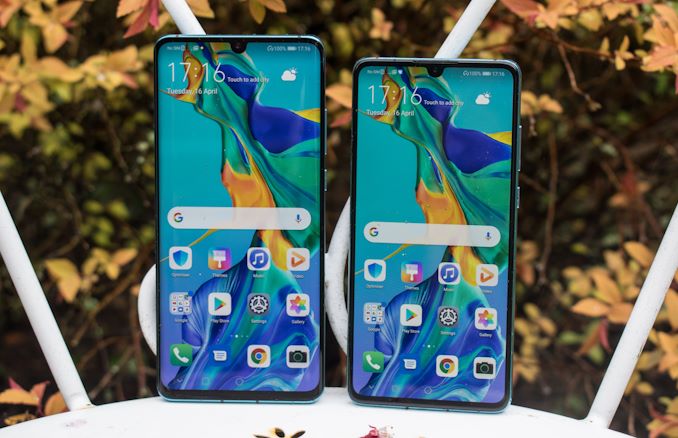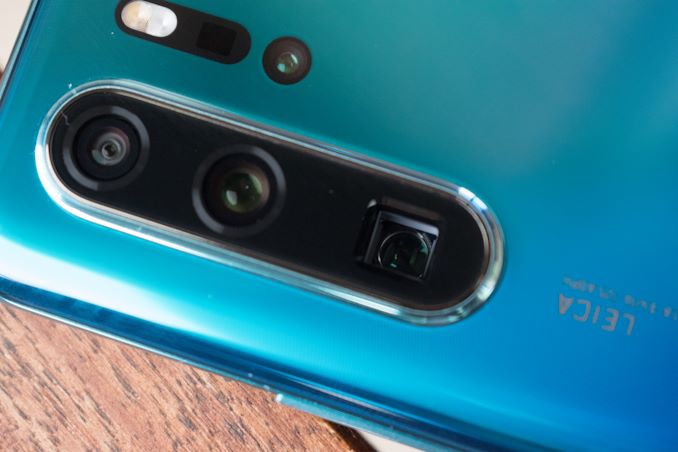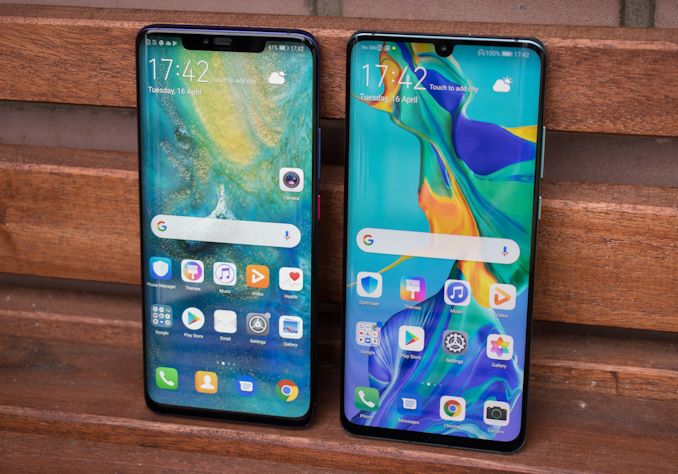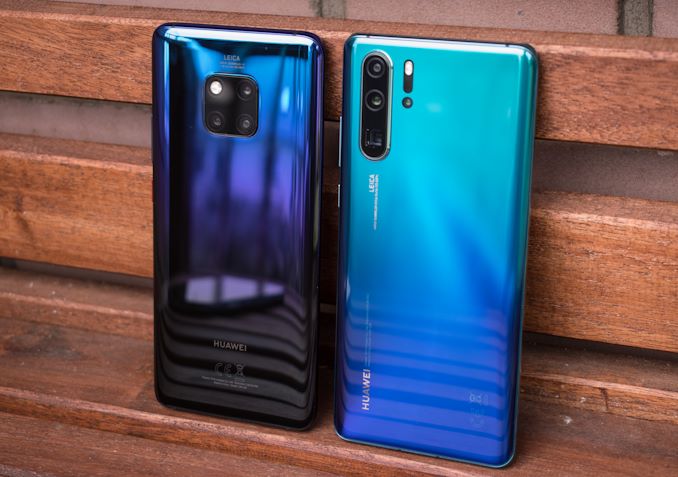The Huawei P30 & P30 Pro Reviews: Photography Enhanced
by Andrei Frumusanu on April 18, 2019 9:00 AM EST- Posted in
- Mobile
- Smartphones
- Huawei
- P30
- P30 Pro
Conclusion & End Remarks
In many ways, the P30 Pro and P30 are both iterative phones. Both devices are taking aspects first introduced in their predecessor P20 series – as well as the sister Mate 20 series – and improving and packaging them into phones with an emphasis on photography.
Design wise, the smaller P30 doesn’t differ all that much from the P20, keeping the same form-factor and also a similar design. Build quality has improved, and the device looks a more premium than its predecessor, mostly due to industrial design changes such the removal of the plastic rim between the body frame and the back glass panel.
Huawei’s choice to go with flat top and bottom frames is quite odd, and it gives the phones a more industrial look and feel than what we’ve become accustomed with compared to the more traditional rounded slab designs.
The bigger P30 Pro adopts the ergonomics of the Mate 20 Pro, meaning it has a curved and flowing display and back cover glass design. I find this design quite fantastic in terms of in-hand feel as well as ergonomics, and it makes the P30 Pro feel like much smaller phone than it actually is. One negative of the new ergonomics is the weight of the phone: at 192g the P30 Pro is a lot heavier than competing devices of its size.
The displays on both P30s are good. Particularly the move to an OLED augments the smaller P30 compared to its predecessor, the LCD-based P20. Huawei was able to seemingly avoid any display issues this time around, as opposed to the concerns of the LG panel units on the Mate 20 Pro. Colour calibration on both phones is good, albeit not excellent. Huawei has achieved better in past models, but it’s not a deal-breaker for the P30s. The only negative about the screens is that I really wish Huawei would have gone 1440p on the P30 Pro – there really is not technical excuse not to adopt it, and it’s just a matter of implementing it correctly.
The dew-drop display notches on the phones are minimal and not intrusive, and I find them better alternatives than what Samsung went with this year.
An odd difference between the two phones is that the P30 has an earpiece speaker while the bigger P30 Pro goes with a piezoelectric under-screen actuator. The problem here is that I just do not see the advantage of these new designs; the earpiece on the P30 is barely visible and sounds better. Unlike Samsung and LG’s recent models, neither of the P30s have stereo playback, and thus lag behind significantly in terms of speaker playback quality. To top off the audio concerns, Huawei continues the senseless design choice of skipping a headphone jack on larger and more expensive P30 Pro while including it on the smaller model..
Both phones have optical under-screen fingerprint sensors, and they’re excellent. The implementation is as good as OnePlus’s, and it’s a much faster sensor than Samsung’s ultrasonic units in the Galaxy S10 series.
The performance of the P30s is excellent thanks to the Kirin 980 SoC. We’ve covered this in past Kirin 980 devices and the new SoC is able to keep up with Qualcomm’s and Samsung’s best for this generation. GPU performance lags a bit behind the flagship competition, but it’s not too bad as it ties in with Snapdragon 845 devices.
Battery life for both phones is excellent, although no longer quite as class-leading, as this title remains with the Mate 20 as well as the new Galaxy S10+.
Cameras Differentiate the P30s
The main selling point of the P-series are supposed to be their cameras, and here Huawei did make some large and interesting changes.
First of all, both P30s now add the wide-angle sensors which were introduced in the Mate 20 series. The additions are fantastic to the shooting experience and Huawei is able to deliver very high quality results, with the P30 Pro having an advantage in quality due to its better sensor.
The zoom optics on the P30 remained the same as what we’ve found on the P20 Pro and Mate 20 Pro – it’s excellent and is able to achieve a higher optical zoom factor than competing devices. Due to the main sensor being 40MP, capturing digitally zoomed in/cropped shots at 2x factor while in 10MP results in little to no quality loss, with the 3x module picking up the slack for further away objects.
While the 5x telephoto module on the P30 Pro is technically impressive in just how far it’s able to go, I’m not very convinced that it’s actually all that beneficial to the everyday capture experience. In particular the device fails to properly bridge the gap between a ~2x and 5x zoom factor, where you’re left with deteriorating image quality and purely digital zooming on the main camera sensor. I honestly do not think that this is how most people use their phones, and I think the 3x zoom on the P30 and previous Huawei devices was a better alternative for the capture experience and most scenarios.
The main camera sensor on the P30s is also interesting. In daylight shots, there are some clear compromises in the new modules. The optics just aren’t as good as what's found on the Mate 20 Pro, and both units suffer from more chromatic aberrations on the outer edges of the images, something that’s immediately visible in the native 40MP capture modes. This issue affects the P30 Pro more than the P30 due to its wider aperture.
Also visible in daylight shots is that detail preservation isn’t as good as the Mate 20 Pro. Besides the optics, this might be caused by the new RYYB sensor which might not have as good pixel isolation as the previous generation sensor.
Daylight processing has changed when compared to the Mate 20 Pro, and while in most cases it’s better, in some cases it also saw regressions. The problem for Huawei is that there’s too large a difference in the processing and resulting images between the different modules. Again I feel as if Huawei putting the responsibility of achieving the best result to the user instead of delivering the best results out of the box. The phones are incredibly versatile in their cameras, but this is also their downfall as they lack consistency.
In low-light scenarios, the P30s are both absolute winners. The new sensor, and particularly the new optics with OIS on the P30 Pro, raise the bar yet again in terms of what one can expect out of a smartphone camera. Huawei’s real only competition here is Google’s Night Sight mode, however once it gets dark enough even the Pixel phones cannot compete with then new Huawei hardware. Compared to other vendors, it’s a completely different league.
Lastly, there’s the question of if the P30 phones are worth their money. Unfortunately I think Huawei’s yet again coming in a little too high on pricing. I have a hard time justifying the P30 Pro’s 999€ price point. The issue here is not only the competition, but also the question of whether this actually represents a better value than say the company’s own Mate 20 Pro, which can now be had for 699€. While impressive, I do not see the 5x telephoto lens as a selling point for the P30 Pro. This leaves the much better low-light capture as the only substantial benefit, as otherwise the P30 Pro represents a downgrade in speaker and display quality, with possibly slightly better battery life.
The P30’s 749€ price seems more reasonable, however again the Galaxy S10 is just 50€ more today, and you’re trading in the excellent low-light capture for an overall better phone.
I think both P30 phones are good devices, however it might be worth to wait a couple of months for the inevitable price drop, as the phones don’t tick all the boxes to be able to justify their launch MSRPs.














85 Comments
View All Comments
Andrei Frumusanu - Thursday, April 18, 2019 - link
The sensor should be in 4:1 binning mode, otherwise the dynamic range would be much worse.No 10-bit HDR or HDR recording.
4K30: 40Mbps AVC High@5.1 // 25Mbps HEVC High@L5
FHD60: 25Mbps AVC High@4.2 // 16Mbps HEVC Main@4.1
The bit-rates are quite low.
eastcoast_pete - Thursday, April 18, 2019 - link
Thanks Andrei! The low bit rates are unfortunate, and likely hurt the quality of the video. If you still have the P30 Pro, could you try the Android app "Open Camera" and see if that allows for higher bit rate recording?In general, I don't get why so many phone manufacturers are hamstringing even their flagships like that. At least give users the option of recording at higher bit rate. These days, even many affordable mainstream microSD cards support write speeds of 60 Mb/s and up.
Andrei Frumusanu - Friday, April 19, 2019 - link
In Open Camera:AVC tops out at 25Mbps at 4K30 for some reason.
HEVC can be set to 80Mbps in the settings and results in a 62Mbps file at 4K30.
eastcoast_pete - Friday, April 19, 2019 - link
Thanks Andrei! Appreciate it! Any comments on how the 80 Mbps video looked like?I suggested to try this to a. learn what the phone hardware can support and b. hopefully motivate/shame Huawei (and others) with your results to improve their camera software. If Open Camera can go up to 80 Mbps in 4K HEVC recording, the phone is clearly capable of higher bitrates than Huawei uses. As someone interested in digital video, I always want to acquire at the highest bit rate possible, and then compress afterwards (thank you, Handbrake team!). Throwing out data is easy, re-creating details is hard or impossible. Also, higher bit rates generally reduce compression artifacts.
s.yu - Friday, April 19, 2019 - link
Hey Andrei, I've been looking at the 40MP shots of the P20P, 30P, and Mate20P, and a very peculiar thing I noticed is that both the P20P and 30P have false color interpolation artifacts, while the Mate20P avoids that; but in terms of chroma noise, Mate20P and P30P are on the same level, while in terms of texture aggregation, the P20P and Mate20P behave similarly.So the suppression of the interpolation artifacts doesn't seem to be due to chroma NR, nor is it in any way correlated to sharpening, *nor is it CFA-bound*, as the P20P shares a CFA with Mate20P while P30P uses RYYB. So do you have any idea why this might be?
I've been examining the area below the left half of the bridge for chroma noise and the pale-looking tree there exhibits a lot of interpolation artifacts in the P20P/30P shots:
https://images.anandtech.com/galleries/7027/P30Pro...
https://images.anandtech.com/galleries/7027/Mate20...
https://images.anandtech.com/galleries/7027/P20Pro...
Andrei Frumusanu - Friday, April 19, 2019 - link
I think all of it is just results of the lens; if you check the centre of other images they all look fine, but it gets worse and worse off-centre for the P20P and P30P.s.yu - Friday, April 19, 2019 - link
Hmmm, I couldn't think of an optical artifact with that kind of behavior...I don't think CA would be especially evident on foliage especially when the lighting of the scene renders it very low contrast. Basically in that really typical scene you're seeing blobs of other colors (which are not actually present) in a cloud of yellowish green.I chose another set and this time there's orange artifacts in the green bush in the center of the scene possibly with magenta artifacts in white or very faintly pink flowers slightly above it(the generally uniform color of the petals seem artificially "split" by the P30P between magenta and white, but I'm not really sure), again neither are visible on bayer or Mate20P.
https://images.anandtech.com/galleries/7025/P30Pro...
https://images.anandtech.com/galleries/7025/Mate20...
https://images.anandtech.com/galleries/7025/Pixel3...
It isn't so obvious in the P20P shot, but the severe texture aggregation rendered it impossible to tell. Usually for these artifacts to show, the pattern's frequency has to be high enough.
Andrei Frumusanu - Friday, April 19, 2019 - link
It's hard to separate sensor effects from post-processing effects. Another thing to take into account is that the P30P sends RYYB data directly to the ISP where things get recomputed. It can be either a DTI issues on the sensor, an ISP recombination issue, or simply a senseless noise reduction filter.neothe0ne - Thursday, April 18, 2019 - link
It looks like the speaker evaluation is missing from the review?Andrei Frumusanu - Thursday, April 18, 2019 - link
I'll be re-adding that soon / tomorrow, I wanted to add a part regarding stereo separation.In general the speaker is good, however it's still a mono bottom firing speaker.